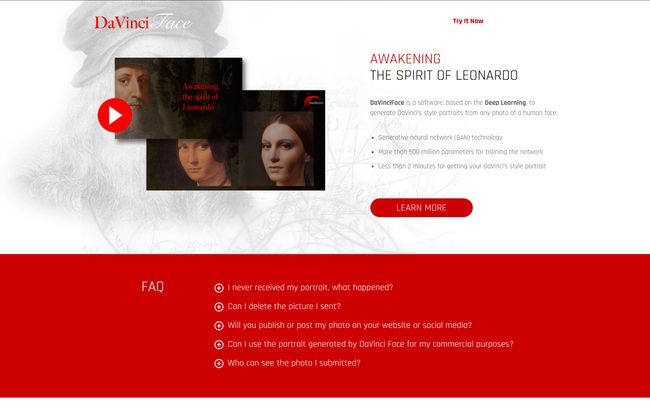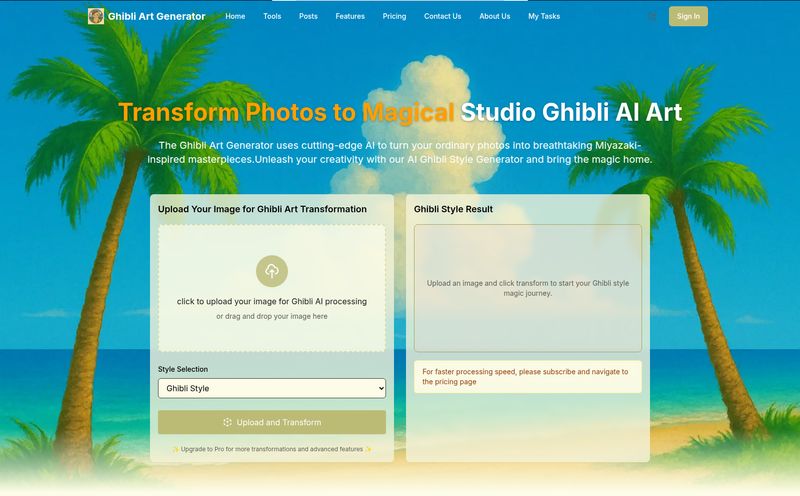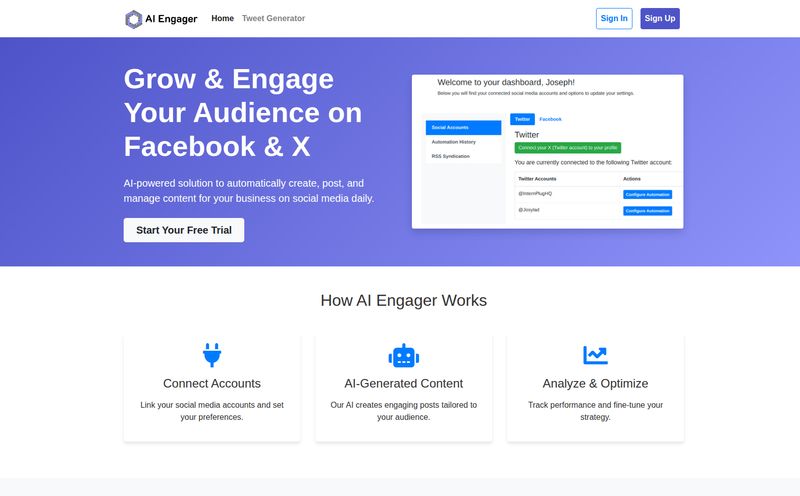We've all seen the mind-bending images from platforms like Midjourney and DALL-E, where you can type in a sentence like "a corgi riding a T-Rex through a field of tulips, impressionist style" and get... well, exactly that. It's wild. It's weird. And I'm here for all of it. But most of these tools are about creating something from nothing, from a text prompt.
So, when I stumbled upon DaVinciFace, my interest was immediately piqued. This one felt different. It wasn't about creating a fantasy world from scratch. Instead, it promised something much more personal: to take your own face, your selfie, and transform it into a portrait as if it were painted by Leonardo da Vinci himself. What an idea! The chance to see yourself as a subject of a Renaissance master? Sign me up.
But as anyone in the SEO and digital trends game knows, promises are easy to make online. I had to know if it was just a glorified Instagram filter or a genuinely impressive piece of AI. So, I grabbed a coffee, a decent selfie, and went down the rabbit hole.
What Exactly is DaVinciFace?
At its core, DaVinciFace is an AI tool that reimagines a photograph of a face in the iconic style of Leonardo da Vinci. And the detail that made me lean in closer? The company behind it, Mathema, is based in Florence, Italy. That's right. The literal heart of the Renaissance. That just feels... right, doesn't it? It’s not some faceless Silicon Valley corp; it's a team in Florence playing with the legacy of their most famous resident.
This isn't just a simple filter that slaps a sepia tone on your photo. The site mentions it uses a Generative Adversarial Network (GAN) with over 500 million parameters. In human terms, think of it like two AIs working together. One AI (the 'Generator') creates the portrait based on your photo. A second AI (the 'Discriminator'), which has been trained on da Vinci's actual work, judges the portrait. It basically says, "Nope, that doesn't look like Leonardo's style, try again." This process repeats itself over and over until the Discriminator is fooled. The result is a newly generated image, not just a modified one. It's a high-tech art forgery, but like, in a good way.
My First Brush with DaVinci: The User Experience
So, I navigated to their site. The interface is clean, no-nonsense. You're there to do one thing, and they make it easy. I chose a recent photo of myself—decent lighting, clear view of my face, no sunglasses. The instructions are simple, but good source material is always the secret sauce for any AI generator.
I uploaded the image, clicked the button, and the AI started whirring. They claim it takes less than two minutes. In a world of long render queues on other platforms, that's a bold claim. I was skeptical. I figured I had time to go make another coffee. But before I could even get up, it was done. Seriously fast.

Visit DaVinciFace
The whole process was incredibly simple. You don't need to be a tech wizard or an art historian to use it, and I appreciate that. It's accessible. But the real question remained... was teh output any good?
The Big Reveal: How Good Are the AI Portraits?
Okay, this is where the magic happens. Or doesn't.
The portrait appeared on my screen, and I have to admit, I was impressed. It wasn't just my face with a brown tint. The AI had genuinely tried to replicate the famous sfumato technique—that soft, smoky blending of tones that Da Vinci was known for. It changed the lighting to mimic the chiaroscuro effect, creating that classic contrast between light and shadow. The texture even had a subtle, canvas-like quality to it.
Did I look like Mona Lisa's long-lost brother? Not exactly. But there was a definite mood, a certain artistic gravitas that a simple filter could never achieve. It felt less like a photo and more like... a digital painting. Some results are better than others, of course. A friend of mine tried it and his glasses got a little wonky in the translation. But with a clear, forward-facing photo, the results are startlingly cool.
The Not-So-Hidden Catch: Pricing and Usage Rights
Alright, let's talk business. The tool is free to try, which is awesome. You can upload your photo and get your DaVinci-style portrait without opening your wallet. But there's always a catch, isn't there? The free portraits come with a small DaVinciFace logo on them. Fair enough, they need to promote their service.
The bigger point, and this is crucial for my fellow creators and marketers, is that the free portraits are strictly for personal use. Their FAQ is clear: you can't use them for commercial purposes. This means you can't slap it on a book cover, use it in an ad campaign, or sell prints of it.
Now, the site was a bit quiet about a formal pricing page when I checked. However, the heavy emphasis on the non-commercial nature of the free portraits strongly implies there's a path to purchase a high-resolution, watermark-free version with a commercial license. This is a common model for AI tools and makes perfect sense. So if you're a casual user wanting a cool new profile pic, you're golden. If you're a professional, you'll likely need to contact them to buy the rights.
Who Should Use DaVinciFace? (And Who Shouldn't?)
This little AI tool isn't for everyone, and that's okay. It’s a specialized instrument, not a multi-tool.
I’d say it’s perfect for social media enthusiasts who want a profile picture that stands out from the crowd, art and history lovers who get a kick out of seeing themselves in a classic style, and anyone who is just plain curious about AI and wants a fun, fast, and easy entry point. It’s a fantastic creative toy.
On the flip side, it’s probably not the right tool for professional digital artists who need granular control over every brushstroke and layer. It's also not ideal for businesses needing a batch of commercial images on the fly, unless they sort out a commercial licensing deal. Some art purists might also scoff at the idea of an algorithm replicating a master. I get that perspective, but I see this less as a replacement for human art and more of a playful homage—a new way to engage with and appreciate an old, revered style.
How Does it Stack Up Against Other AI Tools?
Placing DaVinciFace in the broader AI landscape is interesting. Comparing it to Midjourney is like comparing a finely crafted espresso machine to a fully stocked kitchen. The espresso machine does one thing, but it does it beautifully. A full kitchen can make anything, but it's a lot more complicated.
- DaVinciFace vs. Midjourney/DALL-E: DaVinciFace is hyper-specialized. It does one style, and it starts with your photo. Midjourney and its cousins are text-to-image behemoths capable of infinite styles but with a steeper learning curve. They serve totally different purposes.
- DaVinciFace vs. Photoshop Filters: This isn't even a fair fight. A filter is a simple overlay. It adjusts colors, contrast, and maybe adds a texture layer. DaVinciFace is generative. It deconstructs your facial features and rebuilds them in a new style. It's the difference between putting a hat on someone and giving them a whole new haircut.
The Verdict: Is DaVinciFace a Renaissance or a Gimmick?
So, what’s my final take? DaVinciFace is a brilliant, exceptionally well-executed piece of fun. It’s not going to disrupt the professional art world or put portrait artists out of business. That’s not its goal.
It succeeds beautifully at what it sets out to do: provide a quick, accessible, and surprisingly high-quality way to see yourself through the eyes of a digital Leonardo. The technology is impressive, the user experience is smooth, and the results are genuinely delightful. It's a fantastic example of complex AI being packaged into something everyone can enjoy.
Is it a gimmick? I suppose you could call it that. But it's a darn good one. It's a gimmick with 500 million parameters of sophisticated tech behind it, and one that connects us, however fleetingly, to one of the greatest artistic minds in history.
Frequently Asked Questions about DaVinciFace
- Can I use my DaVinciFace portrait for commercial purposes?
- No, the free portraits generated by the tool are for personal use only. They come with a watermark and cannot be used in advertising, for merchandise, or any other commercial activity. For commercial rights, you would likely need to arrange a purchase.
- Will my uploaded photo be published or saved anywhere?
- According to the platform's FAQ, they prioritize user privacy. The photos are processed to create the portrait and the site states they are not published. It's always a good idea to review the latest privacy policy on any site you upload personal images to.
- How long does it take to get my portrait?
- It's incredibly fast! The process typically takes less than two minutes from the moment you upload your photo.
- Why does my free portrait have a logo on it?
- The logo (or watermark) is included on the free versions as a way for DaVinciFace to promote its service. This is a standard practice for many free creative AI tools.
- What happens if I don't receive my portrait after uploading?
- While the process is usually smooth, technical glitches can happen with any online service. If you don't receive your portrait, the first step is to try again. If the problem persists, you can reach out to them via the contact information on their website.
- Is DaVinciFace just another filter?
- No, it's much more advanced. A filter simply applies a visual layer over your existing photo. DaVinciFace uses a GAN (a type of AI) to analyze your facial structure and then generates a completely new image from scratch in the style of Leonardo da Vinci.
A Final Thought
In a digital world that's often a bit chaotic, there's something genuinely charming about a tool like DaVinciFace. It's not trying to solve world hunger or disrupt an industry. It's just... cool. It’s a nod to the past, powered by the future. If you have a spare two minutes and a decent selfie, I'd say give it a whirl. You might just discover your inner Renaissance muse.
Reference and Sources
- DaVinciFace Official Website: https://www.davinciface.com/
- Creative Bloq Article: "This bonkers AI tool will turn your selfies into Renaissance masterpieces"
- An Explanation of GANs: What Is a Generative Adversarial Network (GAN)? via TechTarget



